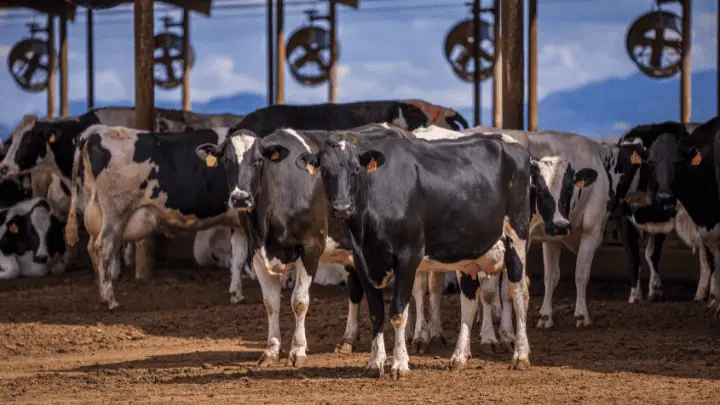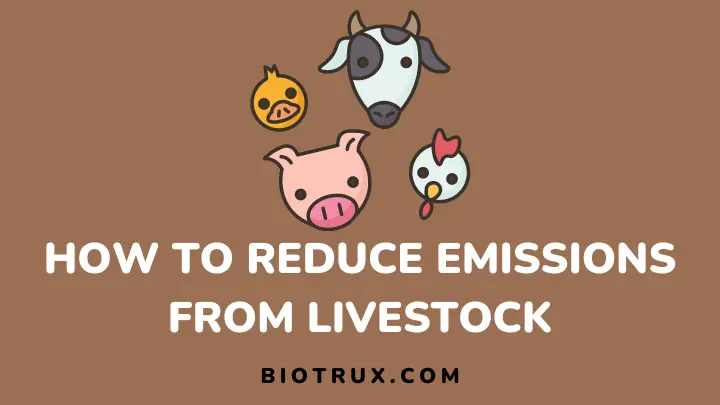Did you know that livestock production is responsible for a staggering amount of greenhouse gas emissions? It contributes more emissions than all the combined cars, planes, and trains. Addressing this issue is crucial to create a greener and more sustainable future.
But fear not – I’m here to offer practical, innovative, and easy-to-implement solutions that can help curb these emissions. Some steps can be taken at every level, from small-scale farmers to large-scale operations, to make a significant difference.
In this article, you’ll explore the various sources of emissions in livestock production and share effective strategies to mitigate them. I’ll discuss the importance of animal dietary changes, explore the power of manure management, and uncover the potential of selective breeding.
If you’re interested in sustainable practices, whether as a consumer, farmer or simply out of curiosity, you’ll find this article useful.
1. Composting
Regarding livestock farming, composting is particularly useful for reducing emissions. Manure left in piles can release methane, a potent greenhouse gas that is even more harmful to the environment than carbon dioxide.
The organic matter is broken down in an oxygen-rich environment by composting manure, reducing methane production. Farmers should establish a designated composting area far from water sources to start composting, with enough space to turn and aerate the compost.
A balance of carbon-rich and nitrogen-rich materials is essential to the composting process. This means mixing the manure with straw, leaves, or wood chips. While composting does require some effort and maintenance, the benefits are numerous.
Composting can reduce greenhouse gas emissions, control odors, and provide a nutrient-rich soil amendment for use on the farm.
2. Use Livestock Feed Additives
Feed additives can help reduce livestock’s methane and other greenhouse gas emissions by breaking down complex nutrients difficult for the animal to digest. For example, some feed additives include organic acids, probiotics, and enzymes.
These additives help promote a healthy gut microbiome in the animal and improve its digestive efficiency, ultimately reducing methane emissions. These additives may be effective, but they should only be used with a veterinarian or nutritionist, as the animal’s health should always come first.
Farmers can reduce livestock emissions and improve farming practices’ sustainability by using feed additives and composting.
3. On-Farm Energy Production
On-farm energy production involves using renewable energy sources like solar, wind, and biomass to generate power on the farm. This can offset the need for electricity from fossil fuel sources and reduce emissions from energy consumption.
For example, solar panels can be installed on barn roofs to provide lighting, cooling, and heating power. In addition, biomass systems like anaerobic digesters can generate energy from animal waste.
These systems capture methane emitted from manure and convert it into usable energy. This reduces emissions from manure and creates a renewable energy source that can be used to power the farm.
On-farm energy production not only helps to reduce emissions but also provides a cost-effective alternative to traditional energy sources.
4. Improved Livestock Management Practices
Livestock farming significantly contributes to greenhouse gas emissions, accounting for 14.5% of all anthropogenic emissions. The production of meat, milk, and eggs releases carbon dioxide, methane, and nitrous oxide.
While eliminating these emissions may not be possible, improved livestock management practices can help reduce their impact significantly. One of the most effective ways to reduce emissions from livestock is to adopt sustainable livestock management practices.
These practices are designed to optimize the use of natural resources, minimize environmental impact, and improve animal welfare. They can include reducing antibiotics and hormones, improving feed quality and quantity, and increasing waste management efficiency.
Improved livestock management practices can help reduce emissions from livestock in several ways. For example, better feed management can reduce methane emissions from enteric fermentation.
Using more efficient feed and reducing wastage, livestock can produce the same amount of meat, milk, and eggs with fewer greenhouse gas emissions. Improving manure management can also reduce methane and nitrous oxide emissions from livestock waste.
5. Implementing Integrated Livestock-Crop Systems
This approach involves combining the raising of livestock with the production of crops. By doing so, livestock waste can be used as a natural fertilizer for crops, reducing the need for synthetic fertilizers, which emit greenhouse gases during production.
In addition, crops can provide a feed source for livestock, reducing the amount of methane produced from the digestion of grains. Integrated livestock-crop systems also help reduce land-use change, significantly contributing to agriculture emissions.
Rather than clearing land for grazing or monoculture crop production, farmers can use the same land for both purposes, reducing deforestation and soil degradation.
Implementing integrated livestock-crop systems is a practical and effective way to reduce livestock emissions while improving soil health and crop yields.
6. Improve Manure Management
When it comes to reducing emissions from livestock, one practical way to do so is by improving manure management. Livestock produces a significant amount of manure which can be a major source of greenhouse gas emissions if not properly managed.
However, with the right approach, manure can be a valuable resource. Improving manure management involves several steps, including:
1. Proper storage: Manure should be stored to minimize contact with air to prevent the release of methane, a potent greenhouse gas.
2. Appropriate treatment: Treating manure can also reduce its emissions. Options include composting, anaerobic digestion, and biogas capture.
3. Efficient use: Using manure as a fertilizer can help reduce the use of synthetic fertilizers, which are energy-intensive to produce.
By taking these steps, farmers can reduce the environmental impact of livestock production while benefiting from the nutrient-rich fertilizer manure produces.
In addition, some states and municipalities offer incentives or assistance to farmers who implement sustainable manure management practices.
7. Agroforestry and Silvopasture Practices
Agroforestry is the integration of trees into farming systems, while silvopasture combines trees with pastureland for livestock grazing. These practices have been found to reduce emissions from livestock, as the trees help to sequester carbon from the atmosphere.
This reduces the overall carbon footprint of the farming system. In agroforestry, trees can be grown alongside grazing land or crops, and provide additional benefits such as shade, shelter, and improved soil health.
Silvopasture involves planting trees within pastureland, which can provide additional benefits for livestock. These benefits include shelter from extreme weather conditions, improved grazing conditions, and reduced stress levels.
Furthermore, agroforestry and silvopasture practices can improve biodiversity, provide habitats for wildlife, and increase the overall resilience of the farming system to the potential effects of climate change.
8. Proper Sensitization of Farmers
Farmers can learn to adopt sustainable and climate-smart practices that reduce emissions without sacrificing productivity. For instance, farmers can learn about the benefits of reducing herd size and managing feed intake, which can minimize methane emissions from livestock.
Proper grazing management practices like rotational grazing can reduce emissions and enhance soil health. Farmers can also learn how to manage manure to prevent nitrous oxide emissions and capture biogas for energy.
Effective sensitization of farmers should involve raising awareness of human and environmental activities and their impact on agriculture. Farmers must be educated on the link between livestock farming and emissions and their role in reducing emissions.
This education can be delivered through various channels, such as extension services, workshops, and demonstrations. Overall, proper sensitization of farmers is a practical way to reduce emissions from livestock.
9. Selective Breeding for Animals with Lower Methane Emissions
Methane is a potent greenhouse gas released during the digestive process of livestock such as cows, sheep, and goats. Selective breeding involves choosing animals with specific genetic traits and breeding them to create a population with those desired traits.
Breeding animals with lower methane emissions can help reduce greenhouse gases released into the atmosphere. Research has shown that some animals naturally emit less methane than others due to differences in their gut microbiome.
By selectively breeding these animals, farmers can produce a more environmentally friendly and sustainable herd. This process can take several years as the desired traits are slowly bred into the population. However, over time, farmers can reduce the overall emissions from their livestock.
While selective breeding is not the only solution to reducing emissions from livestock, it is a practical step that farmers can take to make a positive impact. It is also worth noting that this method is more sustainable than feed additives or other chemicals.
These chemicals can negatively impact the environment and animal health.
10. Reduce Transportation
Livestock transportation is an important aspect of farming. However, it is also a significant source of emissions, contributing to greenhouse gases in the atmosphere. One practical way to reduce livestock emissions is to minimize transportation on the farm.
First, farmers can plan their animal handling practices to minimize transportation needs. For instance, they can avoid frequent movements of animals between different pastures or feeding areas.
Instead, farmers can adopt rotational grazing techniques, allowing livestock to move around on the farm without needing transportation. Another way to reduce transportation on the farm is to keep the animals closer to their sources of feed and water.
By providing easy access to these resources, animals are less likely to move around, and there will be a reduced need for transportation. Farmers can also invest in feed storage and handling systems that allow them to store feed close to the animals, minimizing the need for transportation.

FAQs
What are the primary sources of emissions from livestock?
Livestock emissions primarily come from enteric fermentation, manure management, and land use change. Enteric fermentation refers to the digestive process in ruminant animals, such as cows and sheep, which produces methane as a byproduct.
What is the role of policymakers in reducing emissions from livestock?
Policymakers play a crucial role in promoting sustainable practices within the livestock industry. They can develop and enforce regulations that encourage the adoption of emission reduction strategies.
This could involve incentivizing cleaner technologies, supporting R&D for innovative solutions, and fostering collaborations between farmers, scientists, and industry stakeholders.
Final Thoughts
Reducing emissions from livestock may seem like a daunting task, but it is essential for the health of our planet. While the agriculture industry is vital for providing food and livelihoods, it also contributes to greenhouse gas emissions.
There are ways to minimize the impact of livestock on the environment, and it starts with simple actions, such as those listed above. As consumers, we can also make informed choices when purchasing animal products by choosing those produced with eco-friendly and sustainable practices.
Reducing emissions from livestock is a collective effort that requires cooperation and commitment from all parties involved. As individuals, we can take small steps towards sustainability, and by doing so, we can help preserve our planet for future generations.
Let us all do our part in reducing emissions from livestock and promoting a more sustainable future.
You can also learn more about how urbanization affects agriculture.
Thanks for reading.

